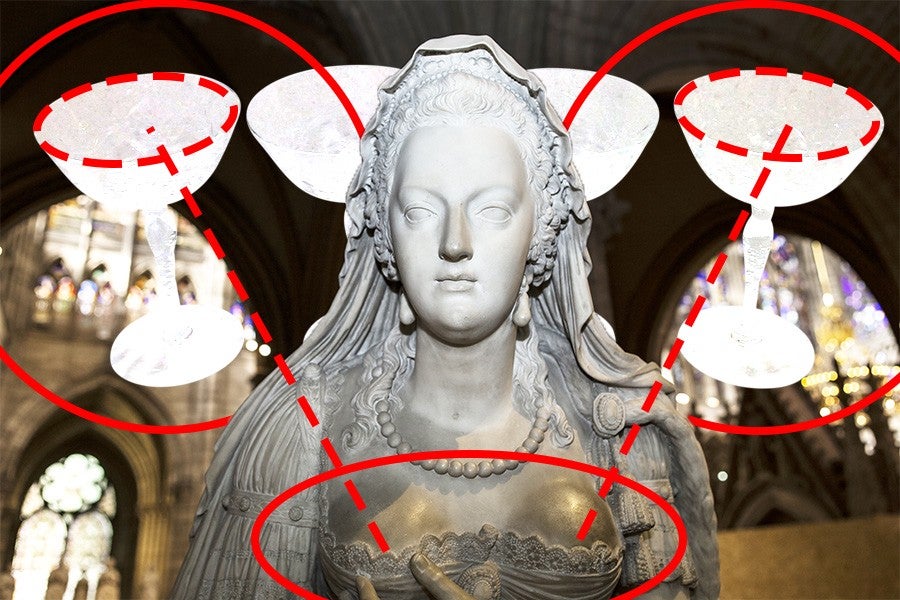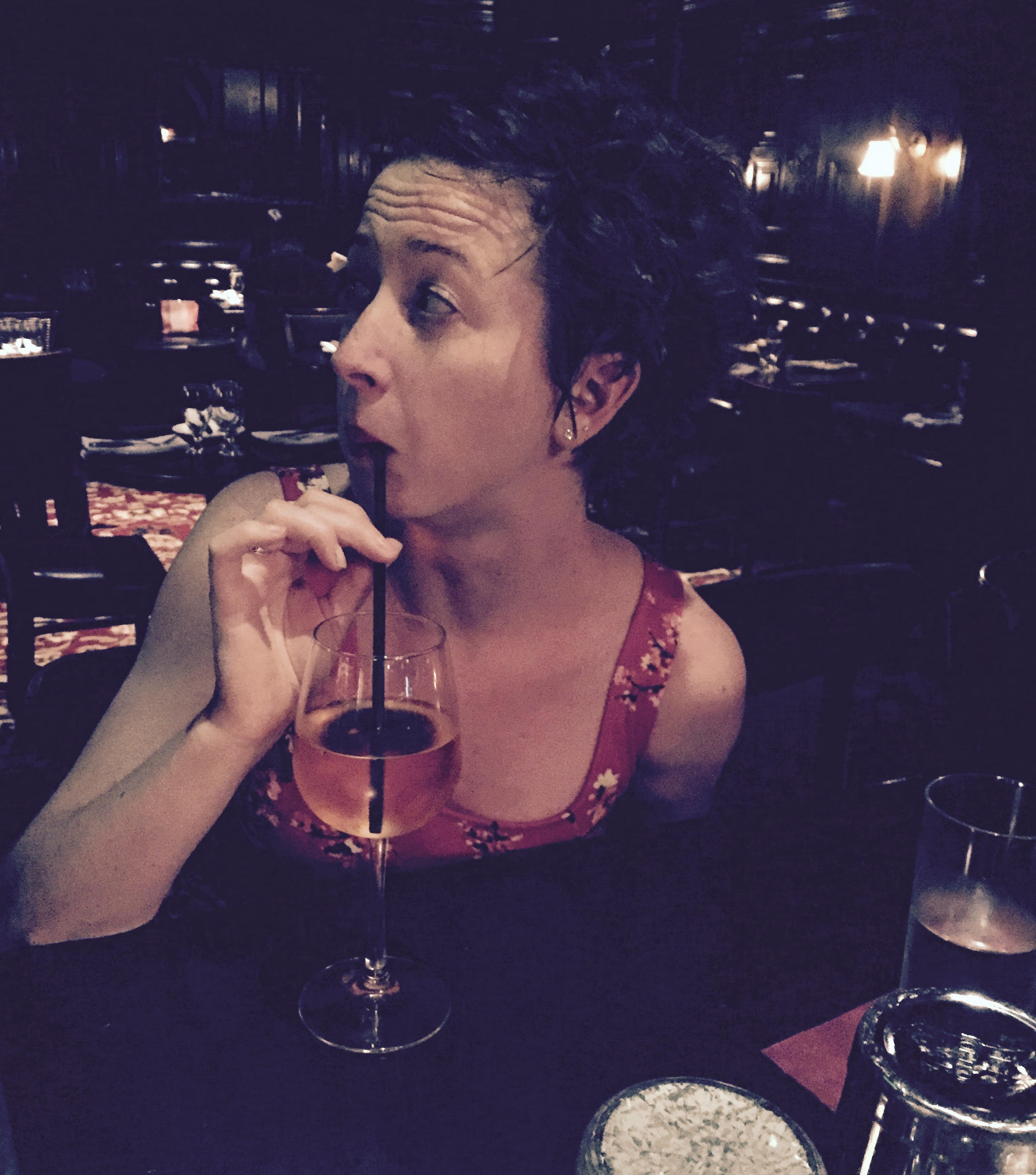Over the summer, a guy came into my bar and ordered a house cocktail called the Shut Up and Play the Hits, a crowd-pleasing combo of vodka, ginger, Thai basil and coconut puree in coupe glass. He, however, was completely baffled when I placed it before him. “Um, what’s this?” he asked, gesturing toward the frothy white monstrosity.
“This? This is the drink you ordered,” I responded.
“Why didn’t you tell me I’d ordered such a bitch drink? I mean, it’s white,” he so eloquently retorted. “Couldn’t you at least put it in a different glass? I’m going to look like such a fag with that glass.”
“But those glasses were modeled after Marie Antoinette’s tits…”
That, of course, completely calmed him. For that “faggy bitch” drink was now in the only vessel that could save it (in his mind at least) — a piece of stemware that was essentially like putting his mouth on a bare breast.
If only it were true.
Coupe glasses, deep, round, ever so slightly tapered bowls of glass set atop a long, thin, stem with a circular base, are today’s standard-issue vessel for cocktails served up. And when viewed upside-down (or perhaps perpendicular to, say, your hand, with the mouth of the bowl resting against your palm), they’re definitely breast-like. There’s even, on most, a little nub at the base of the bowl, where cup meets stem, that looks like a glass nipple. (Go ahead: Line up two empty ones, bend down and look at them, eye level with the center of the glass, and tell me they don’t look like a pair of boobs.)
But they’re most certainly not anything like Marie Antoinette’s boobs. Or if they are, it’s by complete happenstance since they were first produced in 1663, almost a century before she was born.
Yet the legend remains. In fact, nearly every story dissecting the origins of the coupe glass mentions Marie Antoinette’s breasts. And if you Google “Marie Antoinette’s breasts,” all of the search results (and even most of the images) pertain to coupes.
So how did such a bullshit story become so pervasive?
Well, that’s pretty obvious: “Breasts are important to heterosexual men, and always have been,” says Isadora Alman, a board-certified sexologist and licensed psychotherapist. “Which would explain the general acceptance of this rumor.”
And if anyone was liable to have such a rumor attached to her, it was Marie Antoinette, pre-revolutionary France’s promiscuous child-queen. Just 14 when she married Louis XVI in 1770, and with no real power in her title, she threw elaborate parties, wore dresses with enough petticoats to clothe half of Paris and lived like — you guessed it — a queen, while a majority of the country was starving. (The resentment was such that she lost her head to the guillotine in 1792; on the bright side, she was played by Kirsten Dunst in Sofia Coppola’s somewhat recent rendition of her life.)
All the while, she took up residence at a “pleasure dairy.” Less pornographic than they sound (but still rather unseemly), pleasure dairies were popular playthings of France’s aristocratic class. The farms were, essentially, lavish places where female royalty could pretend to do the work of milking cows and preparing food, while the actual labor was done by servants in shoddier surroundings next door. The queen and her guests, often in lavish dresses designed to mimic the frocks worn by the working class, would then be served the milk and food the servants had prepared.
“From the time of its creation, Marie Antoinette’s pleasure dairy has been an essential site in the development of her bad reputation, both as a thoughtless and extravagant queen and as a historical figure who violated the boundaries of her class and gender,” writes Meredith Martin, an assistant professor of art at Wellesley, in her book Dairy Queens.
To complement his wife’s milkmaid fantasy — and possibly get a little kinky about it — Louis XVI commissioned a renowned artist to create a ceramic jatte-tetón or bol à sein (literally “breast bowl”) as a surprise gift for his queen.
The bowl — full, round and milky white with a touch of rosy pink and complete with a nipple at its base — had to be cupped with two hands to drink from and was very similar to a woman’s breast. Still: If Louis was going to surprise his wife with this risque vessel, it couldn’t possibly have been made from a mold of her breast. I don’t care how out-of-touch with reality a person is, they’re going to notice when one of their boobs is covered in clay.
Not to mention that living in the French royal court was essentially the first reality show. Case in point: Antoinette’s bedroom was opened to the public at midday, so that a host of people could watch her put on her makeup. Similarly, her menstrual cycles (their regularity, length and consistency) also were public knowledge, as was how much sex the royal couple was said to be having.
On that last count, it took her and Louis seven years to have their first child, a catastrophe for their families and a blow to their legitimacy as rulers. Rumors flew that the couple had never consummated their marriage, that Antoinette had other lovers, that Louis was impotent, that one (or both, in some stories) preferred the company of their own sex.
So while Antoinette’s hard-partying ways and spending habits make Paris Hilton seem tame and responsible, she was also, in many ways, simply a teenager with too much money and too much free time, unprepared for a life under the microscope of the French court. “Here was a young woman pushed into a loveless marriage, who had little in common with her husband, who had loves of her own which she could not publicly express, who wanted to live her own life, who became the centre of great scandals and died in dramatic circumstances,” Evelyne Lever, author of Marie Antoinette: The Last Queen of France, told the Independent in 2006.
None of which has anything to do with coupe glasses, I know. But that’s because they were the work of the British, who had engineered the wide brim and shallow bowl of the coupe in the 1600s so as to better sip and sniff their champagne, which was super popular with the country’s upper-crust before it took off in France.
I should also mention that coupes went out of style in the 1980s, when the wine-drinking world decided it was the bubbles of sparkling wine that were its key feature. Coupe glasses, with their broad bowl, offered up too much surface area, allowing the bubbles to escape. As such, they were replaced by flutes whose slender, cylindrical vessels contain bubbles more effectively.
Now, though, they’ve come full circle. First, the craft cocktail world adopted them as more elegant alternatives to the pointy martini or cocktail glasses. Then, the wine world changed course again and decided that how a wine smells and how readily available its aromas are when you’re drinking it is far more important than whether the last sip is as bubbly as the first.
That’s why if you order a glass of bubbly today, be it champagne, prosecco, lambrusco or a sparkline wine-topped cocktail like a French 75, you’re going to get it in a coupe glass. Or even more likely, a wine glass since the wider bowl gives you that same access to the nose of the wine, and the higher edges (much higher, anyway, than a coupe) retains bubbles fairly well.
A lot of bars, mine included, don’t even carry flutes anymore.
Which, now that I think about it, is kind of a shame.
Because I heard they were based on Rasputin’s dick.

